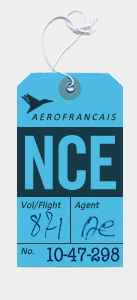 Another year, another booze-fueled, scandal-plagued ego trip on the French riviera. If that sounds harsh, perhaps it is. It’s easier to forgive the excesses of Cannes when they’re accompanied by inspiring work. Unfortunately, this year was a bit of a dud.
Another year, another booze-fueled, scandal-plagued ego trip on the French riviera. If that sounds harsh, perhaps it is. It’s easier to forgive the excesses of Cannes when they’re accompanied by inspiring work. Unfortunately, this year was a bit of a dud.
Few airline industry campaigns were awarded, and many of those that did pick up Lions are retreads of previous years’ campaigns. Last year, airlines took eight Silver and 15 Bronze Lions, already a far cry from the heights of 2014. This year, it was just four Silver and five Bronze, with most of those in lesser categories.
Read more
July 3rd, 2016 \ Posted in Advertising, Awards, Features \ 10 Comments »
 Last year, airlines had a spectacular showing at the Cannes Lions, with a Grand Prix, six Golds, eight Silvers, and eight Bronzes. Inevitably, this year’s performance (eight Silver, 15 Bronze) was not quite so lofty. But there were some strong contenders, along with the usual mix of shocking omissions and perplexing victors that really make you wonder what the hell the judges were thinking.
Last year, airlines had a spectacular showing at the Cannes Lions, with a Grand Prix, six Golds, eight Silvers, and eight Bronzes. Inevitably, this year’s performance (eight Silver, 15 Bronze) was not quite so lofty. But there were some strong contenders, along with the usual mix of shocking omissions and perplexing victors that really make you wonder what the hell the judges were thinking.
Read more
June 28th, 2015 \ Posted in Advertising, Awards, Features \ 11 Comments »
A war of words between Scoot and Spirit Airlines escalated today, according to AdAge: the Singaporean LCC flew a big yellow blimp outside Spirit’s headquarters, defiantly painted with the words, “Hey Spirit, You Can’t Have Our Scootitude!” ((I cringe at having just typed the word “scootitude” and I hope you can forgive me for forcing you to read it.))
Read more
April 17th, 2015 \ Posted in Advertising, Features \ 2 Comments »
By a remarkable coincidence, two U.S. airlines launched new brand identities this week. Southwest revealed its new look at a lavish ceremony on Monday. Frontier unveiled its new look at a somewhat less fancy event earlier today. And the week is young — who knows what excitement is yet to come!
In their own ways, both Southwest and Frontier are returning to their roots. That makes sense for one airline; it’s a perplexing choice for the other. The difference says a lot about what it means to be a “low-cost carrier” today.
Read more
September 9th, 2014 \ Posted in Features, Liveries \ 1 Comment »
 “Champagne, sir?” asks the flight attendant.
“Champagne, sir?” asks the flight attendant.
“Oh, no, I couldn’t possibly,” I answer graciously as I recline in my first-class seat, nonstop from New York to Nice. My seat companion, a famous movie star, wants to hear my story about that shoot I went on that one time, but I’ve already delighted her with it seven times and now I grow weary. I settle in for a few hours of blissful slumber.
Yes, fine, you’re right, this flight is only happening in my imagination. For the fourth year in a row, Branded Skies reports on Cannes from nearly 4,000 miles away.
But what a year it has been for airline brands. For the first time since 2009, work for an airline won a Grand Prix. Of course, it won in the least likely category. But that’s Cannes, where a billboard with no response mechanism at all can be crowned the best direct response work of the year.
It doesn’t have to make sense.
Read more
June 21st, 2014 \ Posted in Awards, Features \ 2 Comments »
Introduction
On the first Monday in March, 1961, the unthinkable struck Eastern Air Lines: a deficit. After 26 years of profits, Eastern declared a loss of $3.6 million.
The loss in 1960 marked the beginning of a decade of change at Eastern. It revealed fundamental problems from which the airline would never really recover. But it also spurred one of the most remarkable reinventions of any airline brand, ever. The changes at Eastern went far beyond a new coat of paint on its airplanes. They reflected an airline that not only portrayed itself differently, but saw itself differently.
For in just ten years, Eastern went from “bums on seats” to “the Wings of Man.”
Read more
June 1st, 2014 \ Posted in Advertising, Features, Jingles, Liveries \ 9 Comments »
[sc_embed_player fileurl=”http://brandedskies.com/wp-content/uploads/2014/03/01-Put-a-dime-in-the-slot.mp3″ title=”Pan Am: “Once in a Lifetime: Put a Dime in the Slot””]
In an age when most Americans fly at least once a year, it’s easy to forget that not so long ago they might have flown just once in a lifetime — if at all. As recently as 1965, only one in five Americans had ever flown on an airplane.
Pan Am was going to do something about that. For them, it was a matter of survival.
Read more
March 7th, 2014 \ Posted in Features, Jingles \ 6 Comments »
[sc_embed_player fileurl=”http://brandedskies.com/wp-content/uploads/2013/11/02-Aeroflot.mp3″ title=”Aeroflot: “Aeroflot””]
In the 1960s, Aeroflot had something of a public relations problem. Although it was then the world’s largest airline — and a vital link for its vast motherland — its reputation for Soviet austerity was well-earned. On domestic routes, passengers endured indifferent service, chronically oversold flights, and uncomfortable aircraft. ((“Flying in Soviet Can Be a Picnic,” The New York Times (6 August 1967).)) The situation was so dire that a 1960 column in Komsomolskaya Pravda, the official newspaper of the youth wing of the Communist Party, openly criticized the state-owned airline: “Unfortunately no genuine concern for passengers is felt in Aeroflot.” ((“Poor Air Service Scored in Soviet,” The New York Times (17 October 1960): 53.))
So Aeroflot did something distinctly un-Soviet: it turned increasingly to Western marketing techniques. Techniques that included a jingle sung by none other than Eduard Khil, Mr. Trololo himself. Read more
November 22nd, 2013 \ Posted in Features, Jingles \ No Comments »
My earliest memory is of a turtle with a peg leg dressed as a pirate. I saw it from the window of an airplane. And I never forgot.
I was 3 years old and my family was on vacation. The turtle wasn’t a real turtle, but the logo on the tail of a jet belonging to Cayman Airways. It’s not surprising that the mascot, nicknamed “Sir Turtle,” would appeal to a young kid—but for me, that turtle kicked off a lifelong fascination with airline branding.
That was shortly after the deregulation of the airlines. In the years since, great airline brands have risen and fallen. Some have disappeared rather suddenly — who could have imagined then an airline industry without Eastern? Or Pan Am? Yet these once iconic brands are long gone.
Indeed, of the remaining U.S. “legacy” carriers, only one — American Airlines — has escaped bankruptcy. Airlines in other countries have fared no better. Their powerful brands have not been enough to save them.
It’s hard not to wonder if airline brands even matter anymore. Read more
April 4th, 2010 \ Posted in Features, Welcome \ 393 Comments »
 Another year, another booze-fueled, scandal-plagued ego trip on the French riviera. If that sounds harsh, perhaps it is. It’s easier to forgive the excesses of Cannes when they’re accompanied by inspiring work. Unfortunately, this year was a bit of a dud.
Another year, another booze-fueled, scandal-plagued ego trip on the French riviera. If that sounds harsh, perhaps it is. It’s easier to forgive the excesses of Cannes when they’re accompanied by inspiring work. Unfortunately, this year was a bit of a dud. 